"Calypso": Aluminium yacht with a wow effect inspired by an exclusive beach bar
Sören Gehlhaus
· 21.09.2023
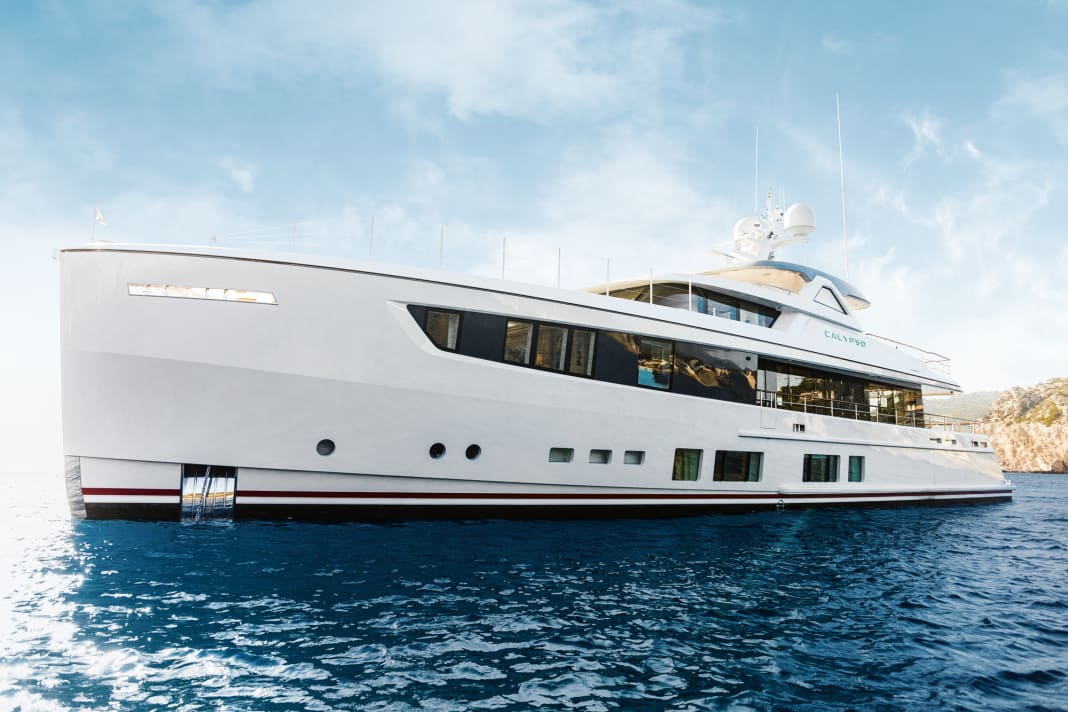





In the harbour entrance of Port d'Andratx, "Calypso" is gently bobbing along and yet looks as solid as the shipyard from which it comes. Mulder Shipyard from Zoeterwoude in the Netherlands has invited her for a sea trial. The service boat takes care of the transfer from the harbour in the west of Mallorca. On board are Dirk Mulder, second-generation shipyard boss and hands-on pedant, his similarly giant-like son Nick - the smart youngster is responsible for sales and marketing - and British designer John Vickers, who earned his spurs with Terence Disdale and Redman Whiteley Dixon and designed the interior of the first ThirtySix for Mulder. As Vickers is also over 1.80 metres tall, the six-metre-long RIB is the perfect means of transport.
We board the 36-metre-long "Calypso" via the stern platform and pass through the beach club into the tender garage, which is richly decorated with teak. The Williams 625 diesel jettender slides like a seal onto the sloping slipway, can be hooked up and pulled by the winch to the parking position lying across the eight-metre-wide aluminium hull. Nick Mulder points to the area in front of two adjacent jet skis: "We've created storage space for toys here that didn't exist on 'Delta One'." This refers to the first construction number launched in 2017, which the owner did not present to the public.
Relaxed beach atmosphere on board the"Calypso"desired
At Christmas 2016, the Mulders decided to launch a second ThirtySix for themselves. "If we hadn't found a buyer for the yacht, we would have chartered it out and used it as a floating showroom," reports Nick Mulder. The yachting-mad family didn't just give themselves a present. "Nick and Dirk finally let me realise the beach bar interior that I've had in mind for ten years. You should feel like you're at 'Le Club 55' in Saint-Tropez, in a relaxed environment where everyone is equal, however glamorous they may be," says John Vickers on the aft deck, the meeting and starting point on "Calypso".
"My father and I spend every spare minute on boats or yachts and want to experience nature. That's why the bulwark on the aft deck is made of glass. The name of the yacht has been engraved into it, and only the letters light up at night!" says a delighted Nick Mulder. It is these technical subtleties that the family team loves to concoct. Just like a camera on the bow, the Dolphin Cam, which is aimed at the stern.
Beach-look carpet
Vickers stands in front of the saloon and emphasises that its nature is best expressed when the sliding doors are open. They were produced by the shipyard's own stainless steel workshop using Tormax components. The carpet is made of imitation silk - a concession to charter suitability and yet an expression of Vickers' sophistication: "I once saw this beach photo with ripples painted into the sand by flooded water. I had it recreated in CAD and cut into the carpet." Wooden blinds, which act as room dividers, reinforce the relaxed beach atmosphere. Only the marble tops of the coffee tables don't seem to fit in at first. Vickers clarifies: "Seen from above, they are small stones washed up by the sea."
The bar on the port side continues the casual flair, with a front made of thin, diagonally overlapping oak planks that look as if they have been woven together. "It has the vibe of bamboo mats, which serve as a cover and sun protection in beach bars. And it absorbs noise." Another Vickers speciality are the ceiling and wall lamps in the style of torches, like the ones you would take with you when crossing over to a deserted beach. The torchlights all look the same size from the aft deck, but they are not, to create exactly this effect.
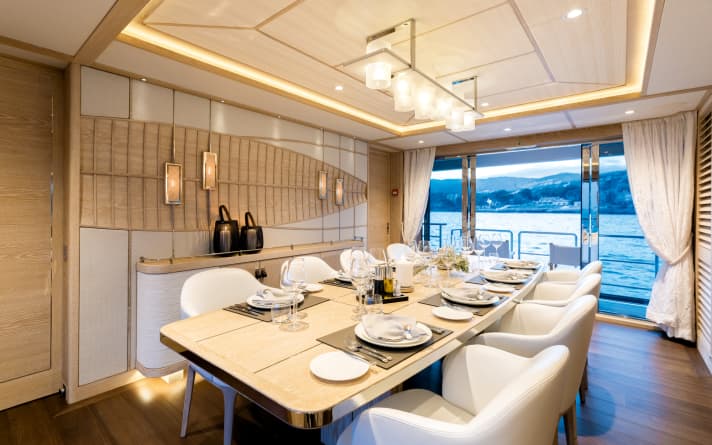
The fact that you are on a yacht, and a Dutch one at that, is indicated by the polished stainless steel lamp surrounds. John Vickers kneels down and looks at the feet of the bar, which, as with all sideboards, appear to form solid crossbars. "Calypso" is a displacer in lightweight construction with furniture made of veneered wood; Mulder's wood professionals had to find suitable veneers for the ends. The wooden 2D outline of a sailing yacht, which is emblazoned above the dining table, is based on a construction drawing by Dirk Mulder's father and shipyard founder, and can therefore be seen as self-referential.
One unit: designer and shipyard
After viewing the first living area, you get the impression that someone is challenging an experienced shipyard in a positive sense. And Mulder's reaction? Let the trades do their thing and add practicality. Behind the hull skeleton, a secret door opens up into a storage space. During the journey from Andratx to Palma, Nick and Dirk often open a door out of nowhere, flip open a panel or floorboard and proclaim: "You can't have enough storage space."
"All these details," Vickers continues, "I didn't think Mulder would realise them. Dirk didn't always do that in the past, but this time the guys really built everything I put on paper. I would never have sent my specifications to another shipyard. It would have gone under." But apart from the fact that Vickers originally designed the interior for the Mulder family, there is a special designer-shipyard constellation. They have known and appreciated each other since working on "Firefly" five years ago. "The owner tried four or five designers. I went from Redman Whiteley Dixon to self-employment and had a lucky hand," says Vickers with British understatement. Six yachts and many prizes followed.
When Nick Mulder found a buyer for "Calypso" in August 2018, all the interiors were largely completed. The new owner liked what he saw. "He only replaced the chairs around the dining table as it is very large," says Nick Mulder, who managed to finalise the deal in time for his father to commission customised stainless steel water drains for the side decks in the metal workshop. They adorn the whale fluke, which forms the Y in the yacht's name at the stern. "The owner commissioned customised paintings from a painter," continues Mulder. The artwork is one of the few delicate items on board. All the fabrics found on the sofas or walls inside are made for outdoor areas. "Everything is very hard-wearing; we have deliberately avoided linen, for example." This is good for charter operations and, according to Vickers, also for the sense of space, as the inside and outside merge into one zone.
VIP cabin with the wow factor
"We conducted a study with the University of Amsterdam on the development of the charter market and realised that many people use yachts the way my father and I do: in shorts and barefoot, relaxed and not formal." Demand has been high right from the start, with only a few slots left in the first season of 2019. The owner wants to stay on board for a total of twenty days. The second master cabin has played a major role in the ship's commercial success.
"Wow!" That's what everyone said when they first saw the VIP, Dirk Mulder and Captain Ian Jinks assure us independently of each other. The visitor tries to forget this and remain neutral. But when the door to the aft lower deck opens, he also utters the most honest of all spontaneous expressions of enthusiasm: "Wow!" Because you wouldn't expect it down here; because a privacy screen in front of the bed initially conceals the size of the cabin; because here, just above the surface of the water, the sea seems close enough to touch.
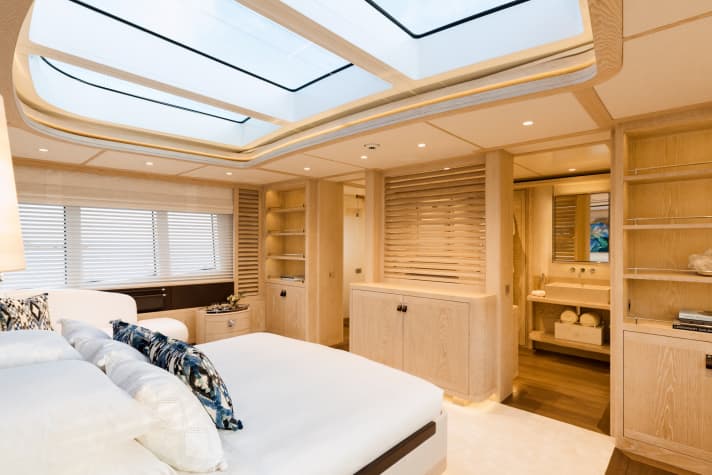
The change from a five- to a four-cabin layout sets the second ThirtySix apart from the first. This seems contrary to the general charter maxim of accommodating as many guests as possible on board. But: "The VIP is just as big as the owner's cabin. It doesn't make friends feel like they're being put off," explains Dirk Mulder, pointing out how the Pullman beds in the two guest cabins can still sleep up to ten guests on "Calypso".
Via the secret door to the foredeck of the"Calypso"
Although equivalent in size, Mulder refers to the VIP on the forward main deck as the owner's suite. This is due to the prominent location, the ceiling, which is ten centimetres higher at 2.20 metres, and the skylights. They are a joint project by John Vickers, who came up with the idea and developed it with exterior designer Claydon Reeves. Dirk Mulder integrated a 3.30 metre wide window area into the superstructure, directly above the bed. Rays of sunlight also illuminate the concave walls next to the headboard. "I added an accent here, as a straight wall would have looked too harsh and pushed the bed into the background," explains John Vickers.
In addition, Vickers combines the oak wood, which is synonymous with a relaxed beach feeling, with solid stainless steel details, as in the lounge: a polished metal trim runs up and down over the wall lamp and breaks through the oak surface. The bathroom also exudes casual splendour. Here, oak meets marble, with a slice of tree serving as a seat in the shower. Afterwards, you could walk in your bathrobe through a room door, a bulkhead door and teak steps through the emergency exit onto the foredeck to everyone's favourite spot, a bench with the best view, without any anchor gear at your feet. This is located one level below.
Captain and crew are a factor in long-term charter success, and nobody knows that better than Ian Jinks. The Brit previously sailed on 50 Rossinavi metres, brought two of his crew members with him and added a further three. The new command is anything but a step down for the captain - he is an instructor for pleasure craft licence examiners and holds a 3000-tonne patent. Jinks stands on the flybridge and enthusiastically provides information about the current performance figures: "We are now running at 14 knots and consuming 240 litres per hour. The efficiency at ten knots is incredible, the consumption is then only seventy litres an hour for both engines. On the crossing from Holland to Gibraltar, the owner saved 15,000 litres of fuel compared to a twelve-knot cruise. We could even have done it on one tank of fuel."
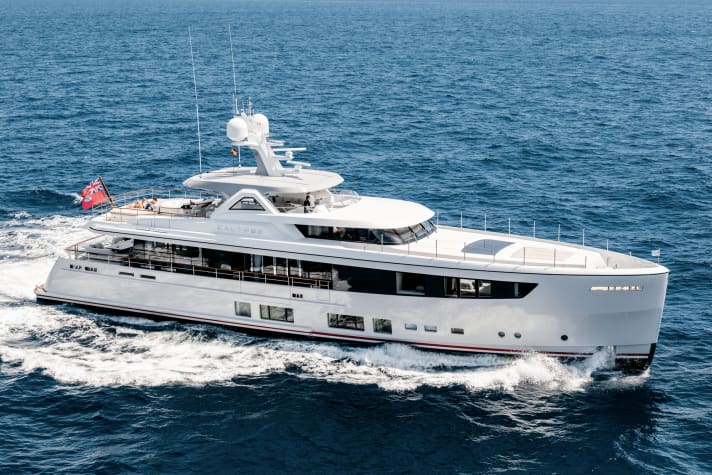
Transfer instead of yacht transport
Dirk Mulder intervenes: "It pays to make long crossings on your own keel and not by yacht transport. I think anyone who claims that cruising speed should be 20 knots or more is crazy. You burn three times more diesel and don't gain much time." After all, 16.8 knots would be possible with the two 847-kilowatt Caterpillar engines.
Shipyard manager Mulder takes us half a deck down to the bridge. "Twelve people can stay here," he says, pointing to the two slightly raised sofa corners. "The crew also use this area as a lounge, but the same materials are used as in the owner's cabin."
Dirk Mulder is constantly on the move and feeds his infamous list, which he keeps on his smartphone. "He does this even when he's on holiday and no matter which boats he's on," laughs Nick Mulder. "The project managers always beat their hands over their heads on his first day at work." His father's aim is always to "simplify life on board" and he doesn't necessarily record any shortcomings in the digital log - there are hardly any on the Calypso - but notes down suggestions for improvement. These are incorporated into build number three of the ThirtySix.
Technical data "Calypso"
- Length over everything:36,05 m
- Width:8,00 m
- Depth:2,05 m
- Displacement (empty):190 t
- Material:Aluminium
- Motor:2 x Caterpillar C18 Acert
- Engine power:2 x 847 kW
- Speed (max.):16.8 kn
- Speed (travelling):10 kn
- Fuel:16.500 l
- Consumption @ 10 kn:70 l/h
- Range:3300 nm @ 10 kn
- Navigation:Furuno
- Bow thruster:1 x 60 kW
- Stabiliser:Naiad Zero-Speed 525
- Tender:Williams Dieseljet 625
- Galley:Miele
- Styling:Claydon Reeves
- Interior design: Vickers Studio
- Construction:Van Oossanen
- Class:ABS A1, MCA LY3
- Shipyard: Mulder Shipyard, 2019
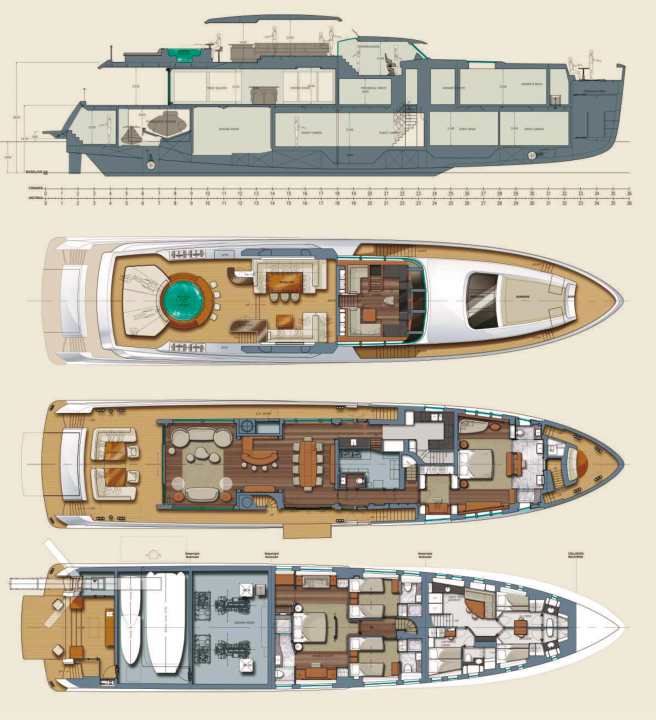
This article appeared in BOOTE Exclusiv issue 05/2019 and was revised by the editorial team in September 2023.

